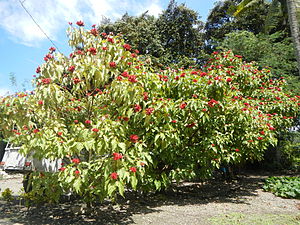Annatto shrub
| Annatto shrub | ||||||||||||
|---|---|---|---|---|---|---|---|---|---|---|---|---|

Annatto shrub ( Bixa orellana ) |
||||||||||||
| Systematics | ||||||||||||
|
||||||||||||
| Scientific name | ||||||||||||
| Bixa orellana | ||||||||||||
| L. |
The annatto shrub ( Bixa orellana ) is a species of plant within the annatto family (Bixaceae). It is native to the Neotropic and is also grown in Southeast Asia.
Common names
It is called Urucum or Uruku in Brazil , Achiote in Spanish-speaking countries and Roucou in French . In German also Orleanstrauch , Rukustrauch , Butterfarb , Stephanulrich , Urian , (red) lipstick tree or incorrectly Caribbean oleander (which, however, correctly describes the highly poisonous bell tree ).
description
Vegetative characteristics
The annatto shrub grows as an evergreen shrub or small tree with a spreading crown and reaches heights of about 6–8 meters. The bark is smooth and brownish.
The simple, longer-stalked and soft leaves are arranged in a spiral. They are lighter on the underside and have entire margins, as well as egg-shaped, the base of the leaves is blunt to more or less heart-shaped, the tip is pointed or pointed to tail. They are up to 25 centimeters long and up to 16 centimeters wide. The petioles are slightly thickened at the base and at the tip. The veins are five-fold and lighter. The stipules fall off early.
Generative characteristics
There are panicles formed and Multiflora inflorescences. The hermaphrodite, short-stalked and fragrant flowers are usually four to five-fold, radially symmetrical and with a double flower envelope . Several glands are located under the flowers on the thickened peduncle. The free sepals fall off early. The larger, obovate and free, spreading petals are white to pink, purple in color. There are many stamens with whitish to pinkish-purple stamens. The unilocular, hairy ovary is constantly above, with a thickish stylus with smaller capitate and two-piece scar .
It is formed with many seeds, long and soft prickly and two-part, brownish or greenish to reddish, egg-shaped to round, up to 4–6 centimeters long and partly acuminate to pointed capsule fruits when ripe . The (20–50) reddish, egg-shaped, round-edged and somewhat flattened or indented seeds are 4–5 millimeters long with a small, whitish aril . The fine-grained, textured seed coat is soft, fleshy.
Chromosome number
The number of chromosomes is 2n = 14 or 16.
use
The seeds of the fruit are used under the name annatto as a spice, as a natural coloring in food and for cosmetic purposes as a red body paint for indigenous peoples, which is applied to protect against sunburn, to repel insects and for spiritual purposes, as well as industrially as raw material for the production of Lipstick . In the tradition of the Tsáchila people , Achiote is used to dye the hair typical of this ethnic group, to which the Spanish-language name Colorados (translated into German as "dyed") goes back.
In southern Mexico, Costa Rica and Nicaragua the achiote seed is used as a spice. In the form of a paste, it serves as the basis for the Cochinita Pibil, popular in the Yucatán, or as a paste (powdered seeds with water) for marinating meat. Achiote has a relatively weak but characteristically earthy taste and at the same time gives the dishes a nice color. It is also used as a rice dye in South America, for example in Ecuador and Costa Rica. In France, the color is used as an additive for mimolette (hard cheese).
The annatto seeds contain a high percentage of delta- tocotrienol , a vitamin E isomer with, among other things, anti-inflammatory effects. It has been extracted for therapeutic purposes in the USA since 1998.
The leaves are used as a remedy for bronchitis and eye infections , among other things .
history
Allegedly Francisco de Orellana (French Orlean) discovered the plant as the first European in the jungles of the Amazon . The vegetable dye was initially used to dye textiles or as a red ink .
Diego Álvarez Chanca, a doctor on Christopher Columbus' second voyage of discovery (September 25, 1493 to June 11, 1496), gave very early written evidence for the use of body painting: “The pomp of the Indians consisted in painting themselves, some black, others white or red, in such varied patterns that their appearance makes you laugh ”.
In 1535, the Spanish chronicler Fernández de Oviedo described the shrub Bixa orellana L. in detail in La Historia General de las Indias .
From 1966 there is a film documentation by Heinrich Harrer ( With the Xingu Indians in Mato Grosso ), which shows how the natives cultivate, process and use the plant for daily personal hygiene.
photos
- Annatto shrub (Bixa orellana)
literature
- Ulrich Schimmel, Helga Schimmel: Indian luxury foods, raw materials and colors. Discovered by conquistadors and used in the Old World. Verlag Die Werkstatt, Göttingen 2009, ISBN 978-3-89533-652-2 , pp. 32–33.
- Bixa orellana at PROTA.
Web links
- AZ of crops
- Gernot Katzer's spice pages
- Literature on Bixa orellana in the Kew Bibliographic Databases (English)
- Heinrich Harrer reports: "50 years of color television" broadcast on August 25, 2017 among the Xingu Indians in Mato Grosso
Individual evidence
- ^ Georg August Pritzel , Carl Jessen : The German folk names of plants. New contribution to the German linguistic treasure. Philipp Cohen, Hannover 1882, p. 60, online .
- ↑ Anchiote (PDF), at University of Guam, CNAS, accessed September 7, 2019.
- ↑ Bixa orellana at Tropicos.org. In: IPCN Chromosome Reports . Missouri Botanical Garden, St. Louis






